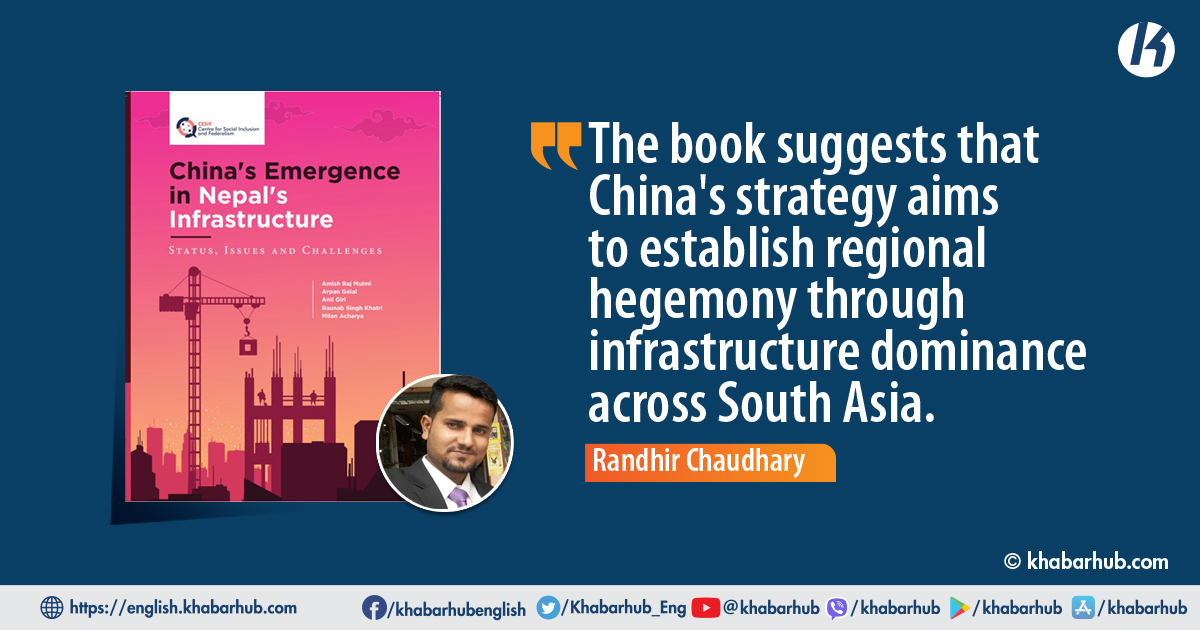The publication, “China’s Emergence in Nepal’s Infrastructure: Stats, Issues, and Challenges,” published by Center for Social Inclusion and Federalism (CESIF), delves into the complex web of China’s involvement in Nepal’s infrastructure development.
CESIF, an autonomous non-profit research organization, has been investigating various facets of international relations, geopolitics, foreign policy, foreign direct investment, identity politics, and military diplomacy, among other topics.
The writers of the book include Amish Raj Mulmi, Arpan Gelal, Anil Giri, Raunav Singh Khatri, and Milan Acharya.
While sporadic mentions of the relationship between Chinese contractors and local agents of Nepali decision-makers have appeared in Nepali media, this book is a groundbreaking endeavor, addressing the dearth of comprehensive research and analysis on infrastructure governance and Nepal’s interactions with Chinese companies and contractors.
Over the course of a year, this report meticulously scrutinizes the concerning aspects of Chinese engagement in Nepal’s infrastructure sector, substantiating its findings with concrete facts.
The book also highlights the shifting dynamics during Nepal’s civil war and bilateral military aid, revealing how China emerged as an alternative source of lethal military aid when India, the US, and the UK suspended their support in response to King Gyanendra’s declaration of martial law in 2005.
In an ever-evolving global geopolitical landscape, this report offers numerous instances illustrating how regional and global interests are intricately woven into the infrastructure investments made by countries such as China, India, Japan, America, and the UK in Nepal, as expounded within its pages.
The book is organized into six distinct sections. The first chapter takes a historical perspective, examining bilateral cooperation efforts and diverse dimensions within Nepal’s infrastructure sector.
In the second chapter, the book aptly aligns with its title, tracing China’s ascent in Nepal’s infrastructure sector, commencing with historical ties between the two nations. Nepal, in fact, was among the first non-socialist countries to receive Chinese assistance in 1956.
During this period, various pivotal projects, including the Araniko Highway connecting Kathmandu to Lhasa, the Prithvi Highway linking Pokhara to Kathmandu, and the Narayanghat-Mugling Highway, as well as hydropower and irrigation initiatives, were initiated.
The report delves into the previously undisclosed facets of China’s investment in Nepal that occurred after the Second World War but before the border dispute between China and India.
For instance, during the construction of the Prithvi Highway, the Chinese Communist Party propagated Maoist ideology, distributing Maoist literature and operating a propaganda theater for the Nepalese people.
This chapter provides a wealth of historical evidence supporting the assertion that China’s actions and strategies in Nepal are intrinsically linked to its relationships with India and the United States.
Notable historical events, such as Prime Minister Zhou Enlai’s discussion of Nepal-India-China relations with BP Koirala in 1960, further elucidate this connection.
Over time, China’s role evolved, including offering to construct the Lhasa-Kathmandu highway free of charge in 1961 and building the Narayanghat-Mugling Highway in 1982 to reduce Indian influence.
The fifth chapter extends the focus beyond Nepal, examining Chinese involvement in South Asian countries such as Sri Lanka, Pakistan, and Bangladesh.
The report also highlights the shifting dynamics during Nepal’s civil war and bilateral military aid, revealing how China emerged as an alternative source of lethal military aid when India, the US, and the UK suspended their support in response to King Gyanendra’s declaration of martial law in 2005.
The report documents China’s controversial arms shipments and the repercussions it faced for its military support of Nepal.
Following Nepal’s entry into the Belt and Road Initiative (BRI) in May 2017, the report details the list of 35 projects initially submitted by Nepal for inclusion, later limited to nine projects at China’s insistence.
The report comprehensively covers these plans, although notable exceptions are Pokhara International Airport and Gautam Buddha International Airport.
In the wake of Nepal’s first post-constitution election in 2015, the unification of CPN-UML and the Maoist Center by KP Sharma Oli and Pushpa Kamal Dahal Prachanda in 2018 piqued Chinese interest.
The book explores this phenomenon and its subsequent unraveling, including the Budhi Gandaki Hydro Project awarded to China’s Gejuwa Group Cement Company during Prachanda’s tenure as Prime Minister.
However, the project’s contract faced controversy and changes as different leaders assumed office.
Chapter three offers a meticulous analysis, supported by evidence, of the questionable collaboration between politicians, bureaucrats, and contractors due to procurement ambiguities in Nepal’s infrastructure investments.
Despite its title, the fourth chapter compares India and Japan’s investments in Nepal’s infrastructure with China’s.
The fifth chapter extends the focus beyond Nepal, examining Chinese involvement in South Asian countries such as Sri Lanka, Pakistan, and Bangladesh.
The book suggests that China’s strategy aims to establish regional hegemony through infrastructure dominance across South Asia.
Lastly, the sixth chapter summarizes the report’s key findings and provides recommendations.
The extensive use of 868 footnotes throughout all six chapters underscores the report’s credibility.
Published on June 30, 2023, this 220-page book offers a comprehensive and insightful exploration of China’s role in Nepal’s infrastructure development.
(Randhir Chaudhary is a Freelance Columnist)









Comment